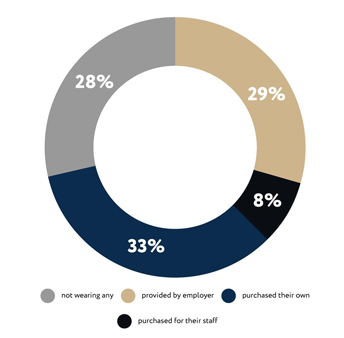The supplier of body armour and related PPE, PPSS Group has published its international body armour survey. Some 729 security people from various countries completed the survey, in February and March 2022. Just over half, 57pc of those taking part were UK based.
The company’s CEO Robert Kaiser said it was of great value to establish what level of knowledge security professionals have about the body armour they are either wearing themselves or purchasing for their frontline staff. He said: “I believe it is absolutely essential that a security professional has a clear understanding of his or her body armour’s capabilities, limitations and life expectancy.
“I equally believe it is of utmost importance for managers and procurement professionals, to share all available body armour performance related information with frontline staff, enabling these men and women to make the best possible decisions in accordance with the body armour’s protection levels and capabilities.”
According to this survey 39pc of participants stated the information given to them about the body armour they are wearing was not sufficient. This means it was not explained to them appropriately what levels of protection their body armour is actually offering, or indeed not offering. Getting on for half, 45pc of participants stated they were not aware of the fact that body armour performance levels in general are only being certified for a limited period of five years. A white paper offers further details.
High levels of physical abuse towards security people came out from the survey, with 78pc of those completing the survey stating that they have been assaulted on duty, many several times. This is echoing other findings, PPSS point out.
The white paper also highlights a need for body armour to provide certified ‘impact’ or ‘blunt force’ protection, after it has been established that 83pc of security professionals completing the survey highlighted the fact they have suffered from severe bruising during physical confrontation. About half, 52pc of those who took part in the survey answered the question “would you benefit from further body armour training” with YES. One could most certainly conclude that people want to know more about their body armour’s performance, certification, and limitations, Kaiser commented.
Pictured; pie chart from the white paper showing survey answers to the question, have you been issued with body armour?” Some 29pc stated their body armour was being provided by the employer, 8pc purchased body armour for their staff, 33pc had purchased their own body armour, and 28pc are not wearing body armour. This percentage split is, at least in the UK, about to change significantly, PPSS suggest. This month the Personal Protective Equipment at Work (Amendment) Regulations 2022 (PPER 2022) came into force, and the employers’ responsibility to supply adequate training and personal protective equipment (including body armour, when deemed necessary by the risk), has been extended to ‘limb workers’, the type of workers registered as self-employed but who also provide a service as part of someone else’s business or contracts. What impact will this have? Those self-employed security people who work on behalf of another security company, but who have historically chosen not to wear body armour (often due to money limits) will have to be issued with body armour by the security provider, PPSS say.
What HSE say
PPER 1992 places a duty on every employer in Great Britain to ensure that suitable PPE is provided to ‘employees’ who may be exposed to a risk to their health or safety while at work. PPER 2022 extends this duty to limb (b) workers and came into force on April 6. Employers need to carefully consider whether the changes to UK law apply to them and their workforce and make the necessary preparations to comply.
If a risk assessment indicates that a limb (b) worker requires PPE to carry out their work activities, the employer must carry out a PPE suitability assessment and provide the PPE free of charge as they do for employees.
The employer is responsible for the maintenance, storage and replacement of any PPE they provide. As a worker, you are required to use the PPE properly following training and instruction from your employer. If the PPE you provide is lost or becomes defective, you should report that to your employer.
More at the HSE website: https://www.hse.gov.uk/ppe/ppe-regulations-2022.htm.
PPE defined
PPE is defined in the PPER 1992 as ‘all equipment (including clothing affording protection against the weather) which is intended to be worn or held by a person at work and which protects the person against one or more risks to that person’s health or safety, and any addition or accessory designed to meet that objective’. Where an employer finds PPE to be necessary after a risk assessment, using the hierarchy of controls explained below, they have a duty to provide it free.
PPSS’ white paper can be found online on the PPSS website: https://www.ppss-group.com/blog/international-body-armour-survey-whitepaper/.










